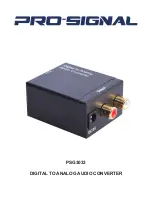
— 53 —
mains connector on the rear panel. The
inappropriate
voltage
and fuse value will have been crossed out at the factory with a
black marker.
To change the mains voltage, first remove the top cover of the
unit. A clearly marked slide switch is right behind the AC
mains connector on the encoder circuit board.
With the mains
disconnected
, use a small screwdriver to set the switch for
115VAC
or
230VAC
operation.
Be sure to install the appropriate fuse listed on the rear panel.
You can remove the factory strikethrough with solvent, and
then cross out the inappropriate marking with an indelible felt
pen.
Power Cord
The detachable IEC-type power cord supplied with the encoder
is fitted with a North-American-standard male plug. The indi-
vidual cord conductors may be color-coded in either of two
ways:
1) In accordance with US standards:
BLACK = AC “HOT”
WHITE = AC NEUTRAL
GREEN = EARTH GROUND
2) To European CEE standards:
BROWN = AC “HOT”
BLUE = AC NEUTRAL
GRN/YEL = EARTH GROUND
RADIO FREQUENCY INTERFERENCE (RFI)
Location
Although it is expected that the 730 may well be installed
alongside powerful FM transmitters, please practice care and
common sense in locating the unit away from
abnormally
high
RF fields.
Ground Loops
Because the unbalanced input and output of the 730 Encoder
are chassis-ground-referenced, a mains frequency or RF ground
loop could be formed between the input or output cable shield
grounds and the AC power cord ground. A ‘ground-lifting’ AC
adapter may well remedy such a situation, although the chassis
must somehow be returned to earth ground for safety. Gener-
ally, being screwed-down in the equipment rack will satisfy the
safety requirement.
SELECTION OF OPERATING MODES
“Regional
Mode”
Selection
The “regional mode” setting for the 730 Encoder; that is, RBDS
for North America and RDS for the rest of the world, is an im-
portant firmware setting already discussed. The proper re-
gional mode may be selected either by the front-panel jog
wheel (Page 13) or by using the Windows® software (Page 39).
















































